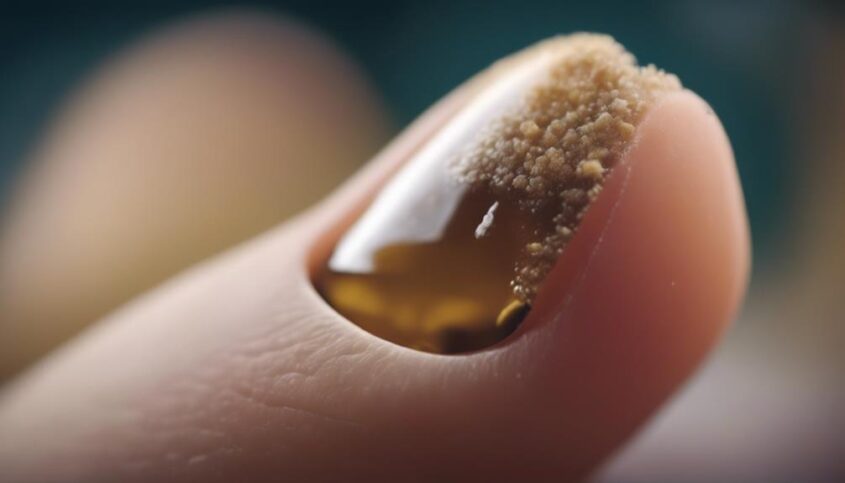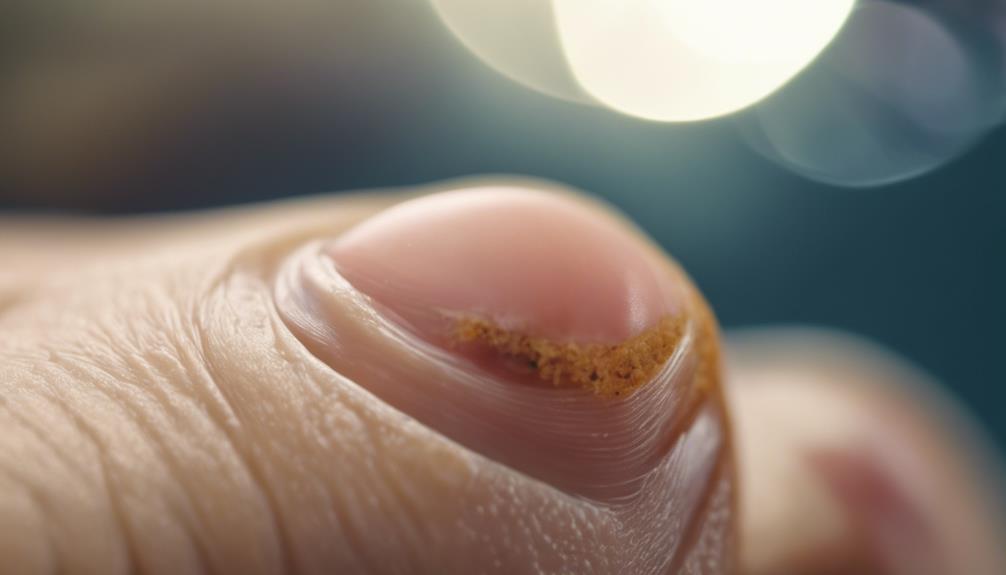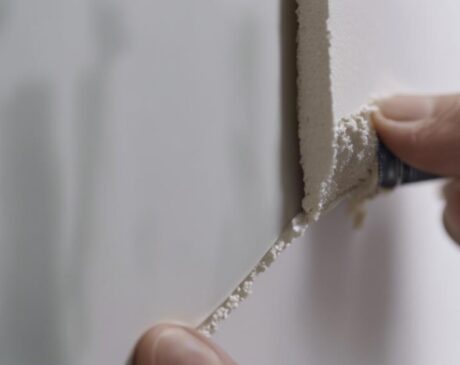Is Toenail Fungus Under the Nail?

Toenail fungus hides under your nail, causing changes you can see. Discoloration, thickening, and odor are signals. It loves warmth and moisture, so watch those shoes. Neglected fungus may spread and bother you. Treat with antifungal remedies or seek expert guidance. Remember, it affects nail health—turning colors, thickening, odors, pain, and brittleness. Signs include yellowing, thickening, brittleness, and shape changes. Act early for effective care. Consider topical or oral meds, laser therapy, or nail removal. Prevent with clean, dry feet, breathable shoes, moisture-wicking socks, good hygiene, and no ingrown nails. Learn more about toenail fungus below.
Key Takeaways
- Toenail fungus typically starts underneath the nail bed.
- Discoloration, thickening, and foul odor are common signs of toenail fungus.
- Fungus thrives in warm, moist environments like shoes.
- Untreated toenail fungus can spread and cause discomfort.
- Combat toenail fungus with antifungal treatments or healthcare professional advice.
Location of Toenail Fungus

When toenail fungus develops, it typically starts underneath the nail. You may notice discoloration, thickening, or a foul odor emanating from your toes. This pesky fungus thrives in warm, moist environments, making your shoes the perfect breeding ground. But fear not, for there are ways to combat this unwelcome guest.
Toenail fungus can spread if left untreated, causing discomfort and embarrassment. You might feel self-conscious about showing your feet in public or wearing open-toed shoes. However, by taking action early on, you can prevent the fungus from spreading and restore your nail health.
To tackle toenail fungus effectively, consider using antifungal treatments or seeking advice from a healthcare professional. Remember, you have the power to take control of your nail health. By staying proactive and maintaining good foot hygiene, you can bid farewell to toenail fungus and step out with confidence once again.
Impact on Nail Health
Toenail fungus can have a detrimental impact on your nail health, leading to discoloration, thickening, and unpleasant odors. When left untreated, the fungus can spread and worsen, causing pain and discomfort. Proper care and treatment are essential to maintaining healthy nails. Here is a table to help you understand the impact of toenail fungus on nail health:
| Effects of Toenail Fungus | Description |
|---|---|
| Discoloration | Nails may turn yellow, brown, or white. |
| Thickening | Nails can become thicker than usual. |
| Odor | Foul smell may emanate from the affected nail. |
| Pain | Discomfort and pain, especially when pressure is applied. |
| Brittle Texture | Nails may become brittle and prone to breakage. |
Signs and Symptoms

Experiencing signs and symptoms of toenail fungus can alert you to potential nail health concerns. If you suspect you may have toenail fungus, watch out for the following indicators:
- Discoloration: Your toenail may turn yellow, white, or even brown.
- Thickening: The affected nail might become thicker than usual.
- Brittleness: Your toenail may become brittle and easily break or crumble.
- Distorted Shape: The nail may start to change shape, becoming oddly curved or ragged.
Noticing these signs can be crucial in addressing toenail fungus early on. Keep an eye out for any changes in your toenails to catch fungal infections promptly. Early detection can lead to more effective treatment options down the line. Remember, taking care of your feet and nails is essential for overall health and well-being.
Treatment Options
Considering the severity of toenail fungus, exploring various treatment options is crucial for effectively addressing this common nail health issue. When dealing with toenail fungus, you have several choices depending on the severity of the infection. Here are some common treatment options you can consider:
| Treatment Type | Description | Pros |
|---|---|---|
| Topical Medications | Applied directly to the nail surface to treat the fungus | Easy to use, minimal side effects |
| Oral Antifungals | Taken in pill form to treat the infection from within | Effective for severe cases |
| Laser Treatment | Uses laser technology to target and kill the fungus | Non-invasive, quick procedure |
| Surgical Removal | Removing the infected nail to promote healthy regrowth | Eliminates severe infections |
It's essential to consult with a healthcare professional to determine the best treatment option for your specific situation. Each method has its advantages, so you have the freedom to choose what works best for you.
Prevention Strategies

Wondering how you can protect your nails from developing fungus? Here are some straightforward prevention strategies to keep your toenails healthy and fungus-free:
- Keep your feet clean and dry: Make sure to wash your feet daily, especially between the toes, and thoroughly dry them afterward to prevent moisture buildup.
- Choose breathable footwear: Opt for shoes made of breathable materials like leather or mesh to allow air circulation around your feet.
- Wear moisture-wicking socks: Select socks that draw moisture away from your skin to help keep your feet dry.
- Practice good foot hygiene: Trim your toenails straight across and avoid cutting them too short to prevent ingrown nails that can create openings for fungus to enter.
Frequently Asked Questions
Can Toenail Fungus Spread to Other Parts of the Body?
Toenail fungus can spread to other parts of your body if left untreated. It's important to address it early to prevent further complications. Consult a healthcare provider for the best treatment options available.
Are There Any Natural Remedies That Can Help Treat Toenail Fungus?
When dealing with toenail fungus, natural remedies like tea tree oil, vinegar soaks, or coconut oil might help. Stay consistent and patient with your treatment. Remember, a journey of a thousand miles begins with a single step.
How Long Does It Typically Take for Toenail Fungus to Completely Clear Up?
Toenail fungus may take several months to completely clear up. Consistent treatment and patience are key. Follow your healthcare provider's advice, maintain good foot hygiene, and consider lifestyle changes for faster healing.
Can Toenail Fungus Be a Sign of a More Serious Underlying Health Condition?
Just as a hidden treasure can reveal itself unexpectedly, toenail fungus can sometimes indicate a deeper health concern. Don't ignore it; consult a healthcare provider to ensure your overall well-being.
Are There Any Specific Lifestyle Changes That Can Help Prevent Toenail Fungus From Recurring?
To prevent toenail fungus from coming back, try wearing breathable shoes, keeping feet dry, and avoiding walking barefoot in communal areas. Trim nails straight across and change socks daily. These habits help reduce the risk of recurrence.




